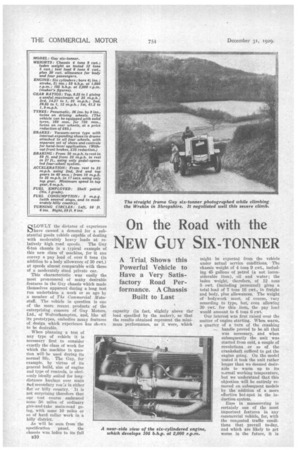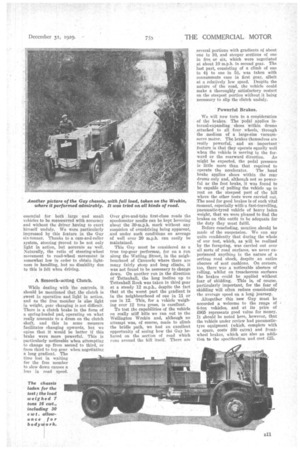On the Road with the NEW GUY SIX-TONNER
Page 44

Page 45

If you've noticed an error in this article please click here to report it so we can fix it.
A Trial Shows this Powerful Vehicle to Have a Very Satisfactory Road Performance. A Chassis Built to Last
SLOWLY the dictates of experience have caused a demand for a substantial goods vehicle capable of dealing with moderately heavy loads at re
latively high road speeds. The Guy 6-ton chassis is a typical example of this new class of machine, for it can convey a pay load of over 6 tons (in addition to a body allowance of 30 cwt.) at speeds almost comparable with those of a moderately sized private car.
This characteristic was easily the most pronounced of many desirable features in the Guy chassis which made themselves apparent during a long test run undertaken a week or so ago by .a member of The Commercial Motor staff. The vehicle in question is one of the more recent products of the enterprising concern of Guy Motors, Ltd., of Wolverhampton, and, like all its prototypes, embodies many features of design which experience has shown to be desirable.
When planning a test of any type of vehicle it is necessary first to consider exactly the class of work for which the machine in question will be used during its normal life. The Guy, for example, by virtue of its general build, size of engine and type of controls, is obviously ideally suited for longdistance haulage over main avd secondary roa.:s in either flat or hilly country. It is not surprising therefore that our test course embraced some 50 miles of ordinary give-and-take main-road going, with some 10 miles or so of hard collar work in a hilly district.
As will be seen from the specification panel, the chassis was laden to its full 810
capacity (in fact, slightly above the load specified by the maker), so that the results obtained represent the minimum performance, as it were, which
might be expected from the vehicle under actual service conditions. The chassis weight of 4 tons 9 cwt., including 45 gallons of petrol (a not inconsiderable item), oil and water; the laden weight, therefore, of 12 tons 5 met. (including personnel) gives a total load of 7 tons 16 cwt., in freight and body, plus allowances. The weight of bodywork must, of course, vary according to type, but, even allowing 30 cwt. for this item, the pay load would amount to 6 tons 6 cwt.
Our interest was first raised over the matter of engine starting. When warm, a quarter of a turn of the cranking handle proved to be all that was necessary, and when subsequently the unit was started from cold, a couple of revolutions or so of the crankshaft sufficed to get the engine going. On the model tested it took the unit rather longer than we deemed desiraide to warm up to its normal working temperature, but we understand that this objection will be entirely removed on subsequent models by the addition of a more effective hot-spot in the induction system.
Ease in manoeuvring is certainly one of the most important features in any commercial vehicle, for, with the congested traffic conditions that prevail to-day, and which are likely to get worse in the future, it is essential for both large and small vehicles to be manceuvred with accuracy and without the driver having to exert himself unduly. We were particularly impressed by this feature in the Guy six-tonner. Thanks to a cam-and-roller system, steering proved to be not only light in action, but accurate as well. Naturally, the ratio of steering-wheel movement to road-wheel movement is somewhat low in order to obtain lightness in handling, but no disability due to this is felt when driving.
A Smooth-acting Clutch.
While dealing with the controls, it should be mentioned that the clutch is sweet in operation and light in action, and es the free member is also light in weight, gear changing is not difficult. There is a clutch brake in the form of a spring-loaded pad, operating on what really amounts to a drum on the clutch shaft, and this in some measure facilitates changing upwards, but we opine that it would be better if this brake were more powerful. This is particularly noticeable when attempting to change up from second to third, or from third to top gear when negotiating a long gradient. The time lost in waiting for the free member to slew down causes a loss in road speed.
Over give-and-take first-class roads the speedometer needle can be kept hovering about the 30-m.p.h. mark without any suspicion of overdriving being apparent, and under such conditions an average of well over 20 m.p.h. can easily be maintained.
This Guy must be considered as a true top-gear performer, for on a run along the Watling Street, in the neighbourhood of Cannock; where there are many fairly steep and long climbs, it was not found to be necessary to change down. On another run in the direction of Tettenhall, the long incline up to Tettenhall Rock was taken in third gear at a steady 12 m.p.h., despite the fact that at the worst part the gradient is in the neighbourhood of one in 11 or one in 12. This, for a vehicle weighing over 12 tons gross, is excellent.
To test the capabilities of the vehicle on really stiff hills we ran out to the Wellington Wrekin and, although no attempt was, of course, made to climb the bridle path, we had an excellent opportunity of seeing how the Guy behaved on the section of road which runs around the hill itself. There are
several portions with gradients of about one in 10, and steeper sections of one in five or six, which were negotiated at about 10 m.p.h. in second gear. The last part, consisting of a climb of one in ft to one in 54k, was taken with consummate ease in first gear, albeit at a relatively low, speed. Despite the nature of the road, the vehicle could make a thoroughly satisfactory restart on the steepest portion without it being necessary to slip the clutch unduly.
Powerful Brakes.
We will now turn to a consideration of the brakes. The -pedal apPlies internal-expanding shoes within drums attached to all four wheels, through the medium of a large-size vacuumservo motor. The brakes themselves are really powerful, and an important feature is that they operate equally well when the vehicle is moving in the forward or the, rearward direction. As might be expected, the pedal pressure is little more than that required to • operate the accelerator. The hand brake applies shoes within the rear drums only and, although not so powerful as the foot brake, it was found to be capable of pulling the Vehicle up to rest on the steepest part of the hill where the other tests were carried out. The need for good brakes is of such vital moment, especially with'a fast-travelling, pneumatic-tyred vehicle of heavy laden weight, that we were pleased to find the brakes on this outfit to be adequate for the duty they must fulfil.
• Before 'concluding, mention .should be made of the suspension. We can .say quite confidently that during the whole of our test, which, as will he realized by the foregoing, was carried out over all sorts of road surfaces, we never experienced anything in the nature of a serious road shack, despite an entire absence of seat cushions. On corners, too, there was a noticeable absence of rolling, whilst on treacherous surfaces the brakes could be applied without fear of skidding. This is, of course, particularly important, for the fear of skidding will often reduce con.siderably the average speed on a long journey.
Altogether this new Guy must be accorded a welcome to the range of 6-ton vehicles, and at its price of i965 represents good value for money. It should be noted here, however, that the vehicle under review had pneumatictyre equipment (which, complete with a spare, costs £60 extra) and frontwheel brakes, which are also an addl. tion to the specification and cost 125.




































































































